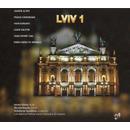 |
Concerto |
|
|
|
for Piano and Orchestra in D minor |
pour Piano et Orchestre en ré mineur |
|
Jean-Pierre Vial composed a first version of the piano concerto in D minor, in 2005, then revised it in 2022 to make it the current version. The concerto consists of three movements, with two lively movements surrounding a slower movement. (The first version also included a brief scherzo, which belonged more in a quintet than in a concerto and which, for this reason, is absent from the final version.) The first movement, allegro ma non troppo, begins with a leitmotiv which, by combining the twelve notes of the chromatic scale, leaves the audience with a questioning feeling. The single theme of the movement follows this brief introduction. Then its developments and reversals are interspersed by the initial leitmotiv, sometimes reversed too. After a short piano cadenza, the final developments conclude with a tutti at the end of which an inversion of the notes of the leitmotiv now gives it a conclusive turn. The beginning of the second movement, adagio, hesitates between both keys of C and D major. After a few piano arpeggios on a syncopated rhythm given by the strings, the piano introduces a melodious theme, first stated in C major by the woodwinds, then forcefully taken up in D major by the piano. The developments of this theme, by the woodwinds and the piano, on the same rhythm given by the strings, is interspersed by the brass stating a second, quite brilliant theme. The adagio ends decrescendo in D major with a descending variant of the initial piano arpeggios, still on the same syncopated rhythm given by the strings. The third movement, rondo vivace, is based on two themes presented alternately. It begins with the piano exposing the first theme, accompanied by the strings, in the key of D minor with an augmented fourth, while the woodwinds gradually start counterpointing. Then the piano states the second theme, a very rhythmic gavotte, in the relative key of F major with an augmented fourth too, on which the horns in turn start counterpointing. The piano then, in arpeggios, accompanies the developments of both themes, during which the brass gradually enters the scene. The rondo ends with a chromatic rise that the instruments gradually join crescendo to form the final tutti. In October 2022, as part of their “Contrasts” festival, the Lviv National Philharmonic Orchestra of Ukraine, with Volodymyr Syvokhip, conductor, and Oksana Rapita, soloist, premiered this concerto in Lviv, Ukraine. To watch the video of the concert, click this link. The same orchestra then recorded the concerto (as well as five other pieces of the same festival) on the CD referenced UPC 731093480430, shown above. You can listen to the recordings of the concerto by clicking these links: I. Allegro ma non troppo, II. Adagio, III. Rondo vivace. The score of the concerto, including a piano reduction, is published by Universal Edition. The work is registered with SACEM. ● |
Jean-Pierre Vial composa en 2005 une première version du concerto pour piano en ré mineur, puis la révisa en 2022 pour en faire la version actuelle. Le concerto comprend trois mouvements, avec deux mouvements vifs encadrant un mouvement lent. (La première version comprenait aussi un bref scherzo qui avait plus sa place dans un quintette que dans un concerto et qui, pour cette raison, ne figure plus dans la version actuelle.) Le premier mouvement, allegro ma non troppo, débute par un leitmotiv qui, en combinant les douze notes de la gamme chromatique, laisse sur impression interrogative. L'unique thème du mouvement suit cette brève introduction. Puis ses développements et renversements sont régulièrement interrompus par le leitmotiv initial, parfois renversé lui aussi. Après une courte cadence du piano, les derniers développements se concluent par un tutti à la fin duquel une inversion des notes du leitmotiv lui confère maintenant une tournure conclusive. Le début du deuxième mouvement, adagio, hésite entre les tons d'ut et de ré majeur. Après quelques arpèges sur un rythme syncopé donné par les cordes, le piano introduit un thème chantant, d'abord énoncé en ut majeur par les bois, puis repris avec force au piano en ré majeur. Les développements de ce thème, par les bois et le piano, sur le même rythme donné par les cordes, est entrecoupé par les cuivres énonçant un second thème plus brillant. L'adagio se conclut decrescendo en ré majeur sur une variante descendante des arpèges initiaux au piano, toujours sur le même rythme syncopé donné par les cordes. Le troisième mouvement, rondo vivace, s'appuie sur deux thèmes présentés en alternance. Il débute par l'exposition au piano du premier thème, accompagné par les cordes, dans le ton de ré mineur avec quarte augmentée, pendant que les bois entrent progressivement en contrepoint. Puis le piano expose le second thème, une gavotte très rythmée, dans le ton relatif de fa majeur, utilisant lui aussi la quarte augmentée, sur laquelle les cors entrent à leur tour en contrepoint. Le piano accompagne ensuite en arpèges les développements des deux thèmes, au cours desquels les cuivres entrent progressivement en scène. Le rondo se conclut par une montée chromatique que les instruments viennent progressivement rejoindre en crescendo pour former le tutti final. En octobre 2022, dans le cadre de son festival “Contrastes,” l'Orchestre National Philharmonique de Lviv, sous la direction de Volodymyr Syvokhip, avec en soliste la pianiste Oksana Rapita, a enregistré ce concerto en première mondiale à Lviv (Ukraine). Pour regader la vidéo de ce concert, cliquez sur ce lien. Le même orchestre a ensuite enregistré le concerto (et cinq autres pièces du même festival) sur le CD référencé UPC 731093480430, figuré ci-dessus. Vous pouvez écouter ces enregistrements du concerto en cliquant sur ces liens : I. Allegro ma non troppo, II. Adagio, III. Rondo vivace. La partition du concerto, ainsi qu'une réduction pour piano, est publiée par Universal Edition. L'œuvre est référencée auprès de la SACEM. ● |
No comments:
Post a Comment